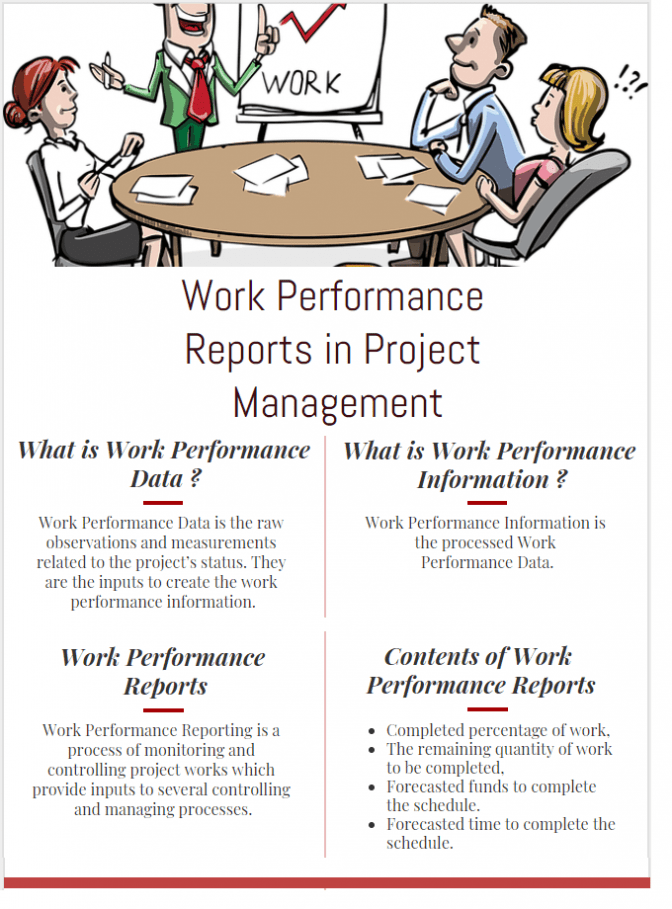Work Performance Data, Information and Reports in Project Management
Monitoring and controlling the status of the project is essential for the success of any organization. Typically, Work Performance Reports provide a general view that helps to understand if a project is performing as it is planned or is deviated from the original plan. From this aspect, performance reports are very important project documents for both project managers and stakeholders. They provide a clear picture of the project’s current performance. If the project is performing as planned, the project team and stakeholders feel comfortable, otherwise, they must struggle to bring the project on track. In this article, we will talk about the importance of project performance reporting and discuss the tools and techniques.
Table of Contents
Before starting, let’s review the work performance data and work performance information topics to provide a better understanding of the concept.
What is Work Performance Data?
Work Performance Data is the raw observations and measurements related to the project’s status. They are the inputs to create the work performance information.
What is Work Performance Information?
Work Performance Information is the processed Work Performance Data. Work performance information is the input of work performance reports. Status of deliverables, the status of change requests, and forecasted estimates to complete are some of the examples of Work Performance Information.
Work Performance Reports
In order to evaluate the project’s current performance, stakeholders need feedback from the project team. These feedbacks generally include the comparisons of planned and actual figures. They can be collected to analyze a project’s resource efficiency, direct costs and indirect costs, and schedule variance.
Work Performance Reporting is a process of monitoring and controlling project works that provide inputs to several controlling and managing processes.
Simply put, Performance Reports are the inputs of the below processes.
- Integrated Change Control
- Manage Communication
- Control Procurement
- Manage Project Team
- Control Risks
Typically, they are the physical or electronic representation of work performance information which helps to generate decision or raise issues, actions, or awareness.
As per these definitions, Work Performance Reports include technical information and progress indication for the key project tasks and deliverables.
As we mentioned above, Work Performance Information is another concept. It is used to create reports. Sometimes professionals mistakenly consider that they are the same.
Basically, Work Performance Reports may include any type of information related to parameters and updates on the project’s progress.
Below are some of the information that can be used to create work performance reports.
- Planned value of the performed work
- Completed and remaining work quantity
- Earned Value
- Actual Costs
- Cost Variance (CV)
- Schedule Variance (SV)
- Cost Performance Index (CPI)
- Schedule Performance Index (SPI)
- Delays on the critical path
- Major identified risks
- Major approved and received change requests, claims
- Quality performance
- And other related important forecasts and issues.
Reporting tools such as network diagrams, tables, histograms, S Curves, Pareto Chart, Control Chart, Run Chart, Burndown Charts, etc. can be used while creating reports.
Contents of Work Performance Reports
Work performance reports may include but not limited to the following project information;
- Completed percentage of work
- Project performance analysis
- The remaining quantity of work to be completed
- Forecasted funds to complete the schedule
- Forecasted time to complete the schedule
- Status of the major change requests & approved changes
- Current status of the major project milestones
- Major identified risks
Importance of Performance Reporting in Communication Management
Performance reporting is an important process that includes collecting performance information, communicating the progress, and forecasting the future status of the project as indicated in the communication management plan.
Basically, reports provide invaluable information regarding the project’s current and past achievements. They enable to make estimation considering the analysis. They are effective communication tools that facilitate communication and coordination between the project team and stakeholders.
An Example
For example, if the project team determined by analyzing reports that the project has deviated from the original plan, they may discuss this issue with the funders to provide extra funds to bring back the project on track.
Note that wrong or incomplete reports may lead to wrong decisions.
Which Formats Can Be Used to Create Work Performance Reports?
Formats of the work performance reports can be determined in the communication plan. They can be in detailed, summary, tabular, graphical, and text-based forms.
Basically, performance reports provide comparisons of the current project performance to the baseline. Status Reports, Progress Reports, Forecasting Reports, Trend Reports, Variance Reports, and Earned Value Reports are some of the types that are widely used.
Summary
Performance Reporting which uses various tools and techniques is one of the most important processes in Project Communication Management. It involves gathering data, collecting project information, comparing the planned and the actual project status, calculating the current and estimating the future performance, and other related practices.
Simply put, reports are communication tools that improve the project team’s and stakeholder’s decision-making.
According to the Project Communication Plan, Work Performance Reports are used to communicate and discuss issues related to performance, cost, quality, resources, delays, risks with the stakeholders. If the stakeholders decide that the project is behind the schedule, above the budget, they may decide to take corrective actions. The distribution of Performance Reports should be done as per the Project Communication Management Plan.
Note that Work Performance Data, Work Performance Information, and Work performance Reporting are three interrelated concepts. Understanding them and knowing their differences will help you to pass the PMP certification exam. You may encounter a few questions.
What do you think about the importance of performance reporting? What kind of performance reporting tools and techniques are you using to communicate with stakeholders? If you have anything to add or share, you can do it through the comments section below.
External Reference
Performance measurement for projects
See Also
Kickoff Meeting Agenda Template

Vice President, İntelligent Design & Consultancy Ltd
Over 12 years of global & rich experience in Portfolio & Program Delivery Management in leading & managing IT Governance, PMO, IT Portfolio/Program, IT Products, IT service delivery management, Budget Management, and more.
















